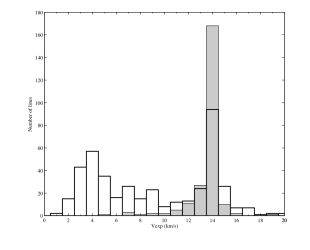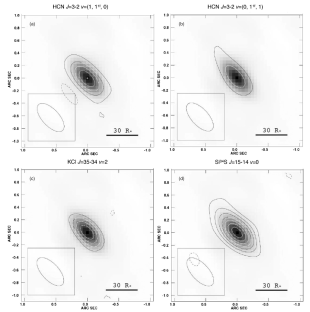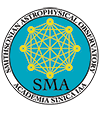|
Inner Envelope/ Dust formation & Accelaration region
Observations for the SMA line survey of IRC+10216 in the 345 GHz band were completed in early 2009 and a paper for ApJ Supplement Series was submitted recently. A total of 440 lines were detected in the central region of 2" x 2" with roughly half of them detected for the first time. A large new sample of lines with narrow widths implying expansion velocities of 4-7 km/s was found from the survey (see Figure 4; Patel et al. 2009a).
 |
Click here for larger view |
Figure 3: Distribution of expansion velocities obtained from observed line-widths. Grey histogram shows the data from single-dish line survey of IRC+10216 (He et al. 2008) which is representative of all previously published surveys. White histogram with bold outline shows the large sample of new lines found in the SMA line survey with expansion velocities < 10 km/s, with a secondary peak at ~4 km/s (Patel et al. 2010). |
Many of the narrow lines are rotational transitions in vibrationally excited states of known molecules such as SiS and CS. But among them was a first detection of vibrationally excited CO emission in J=2-1 and 3-2 transitions (Patel et al. 2009b). Subsequent observations with the extended SMA (eSMA = SMA + JCMT + CSO) at angular resolution of 0.2" x 0.4" show this emission to be unresolved, implying that the emission is arising from a region smaller than 30 AU. Vibrationally excited emission from HCN and KCl was also observed with the eSMA (see Figure 5), probing the innermost region of the envelope in IRC+10216 (Shinnaga et al. 2009). Detection of these numerous narrow lines suggests that we are probing the innermost region of the envelope where the gas is still being accelerated. Modeling of the intensity and shape of these lines should provide stringent constraints on the wind acceleration process and the physical conditions in the inner region.
 |
Click here for larger view |
Figure 4: eSMA observations of IRC+10216. Maps of integrated intensity emission in HCN v=(1,11f,0) J=3-2 and KCl v=2, J=35-34 and Si34S J=15-14 lines, overlaid on continuum emission of the dust and photosphere (Shinnaga et al. 2009). |
» Next Page: Circumstellar Chemistry
« Previous Page
SMA Research
| 


